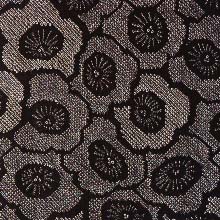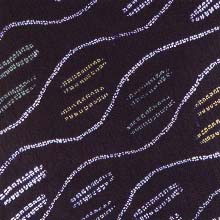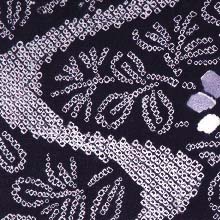Dye (p. 91 )
1. Produced in Arimatsumachi, Narumimachi Midoriku, Nagoya City, Aichi Prefecture.
2. Characteristics: Dyeing of cotton produced in Arimatsu and Narumi. The color was only indigo in the past and the dyed cotton cloth was used for summer dishabille and hand towels. Other colors are used today and they are applied not only to cotton but also to silk and used for Western clothes.
3. Uses: Clothing, hand towels, Western clothes.
4. History: A man in Arimatsu,, who participated in the construction of Nagoya Castle in Keicho Era(1596-1615), started dyeing hand towels of cotton produced in this area in spotted patterns after imitating tie-dyed clothes worn by masons and warriors in Bungo(Oita Prefecture). A wife of a medical doctor named Miura, who moved from Bungo to Arimatsu, also developed the Arimatsu Dyeing by teaching local people the technique of tie dyeing. Then it was called "Miura tie dye" after the name of the doctor. The Arimatsu dye became popular as a special product in Owari Feudal Domain as Arimatsu was a post town. Quality was improved and the variety of dyes increased: red and purple, in addition to indigo, were also used. Arimatsu Shibori was most flourishing in 1690ユs, when the custom to wear dishabille after a bath was widely fixed.
Dyeing Method
1. Sketching. The paper stencil is put on plain white cloth and the liquid, called "Seika Eki"(blue flower liquid), made from the flower of "Murasaki Tsuyukusa"(dayflower, Commelina communis) is applied on the stencil. Today, synthetic liquids are used instead.
2. Tie-dyeing. The tying work is mostly done by housewives. There are more than one hundred and scores of ways of tying and many people hold their own tying techniques in many areas.
3. Dyeing. The cloth is dried after the Seika Eki is removed. Indigo was the main dye before but chemical dyes are used for dip-dyeing today.
4. Finishing. After fully dried, the tying threads are drawn. Then, the cloth is steamed and stretched with a tenterhook.






